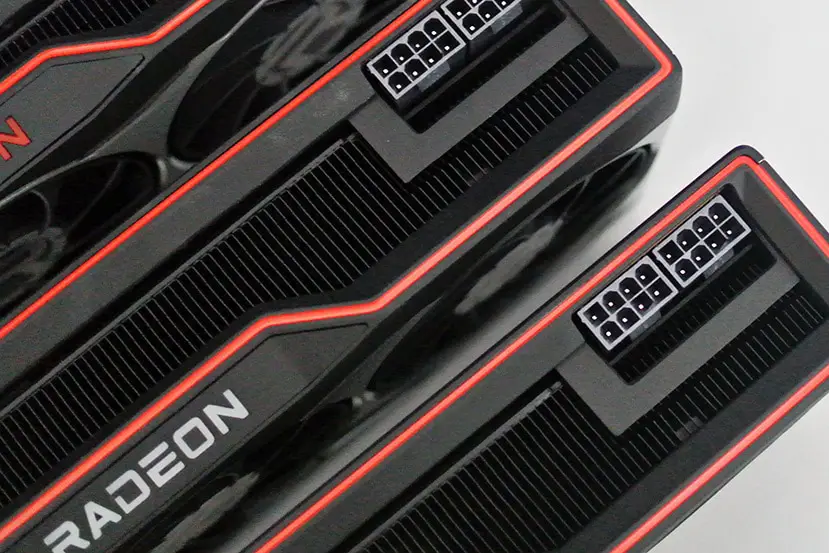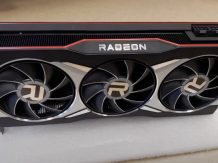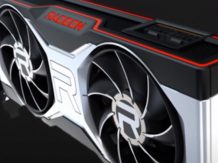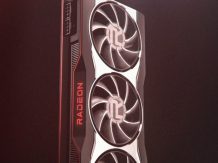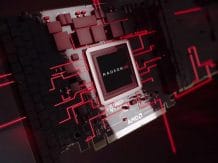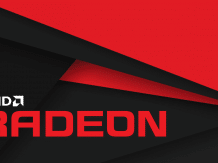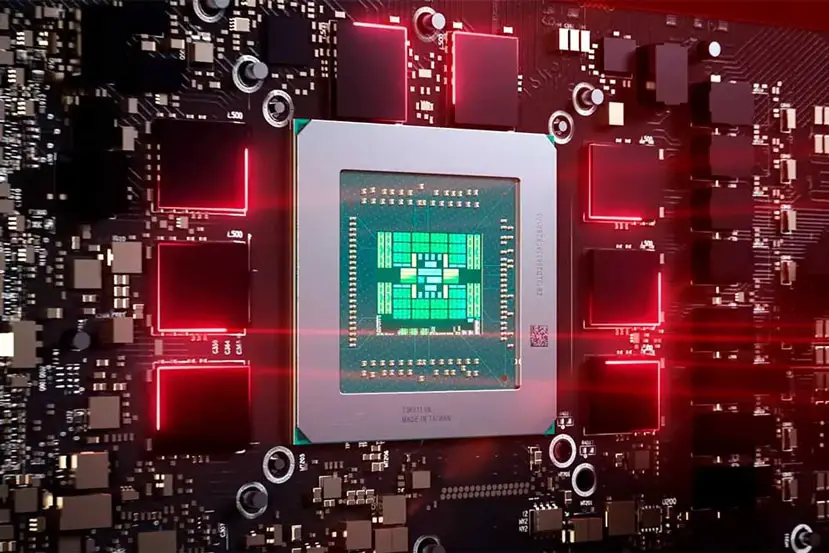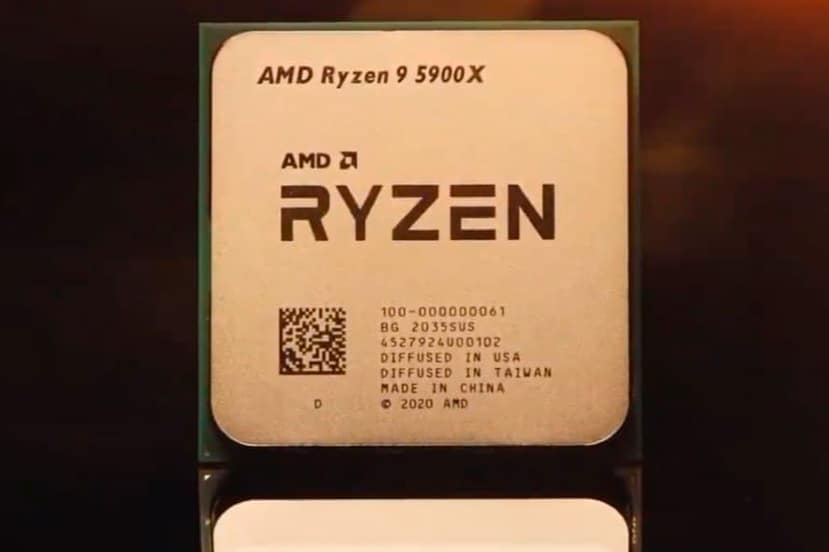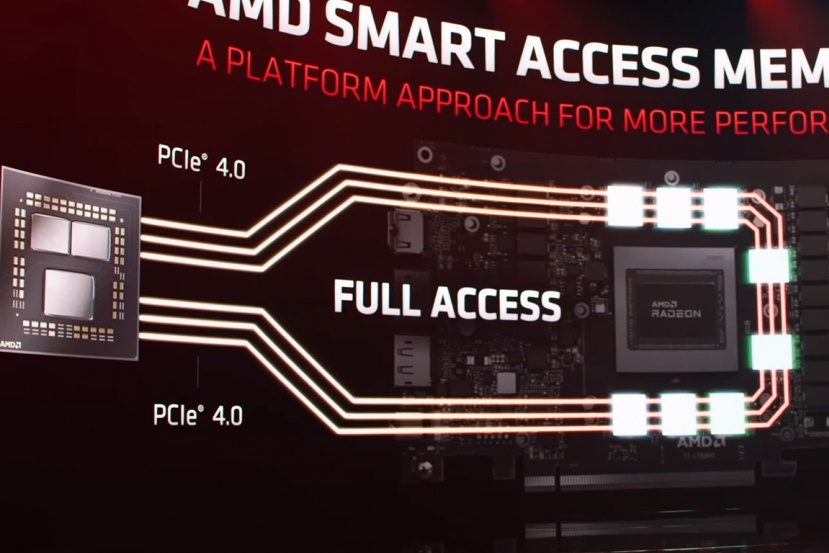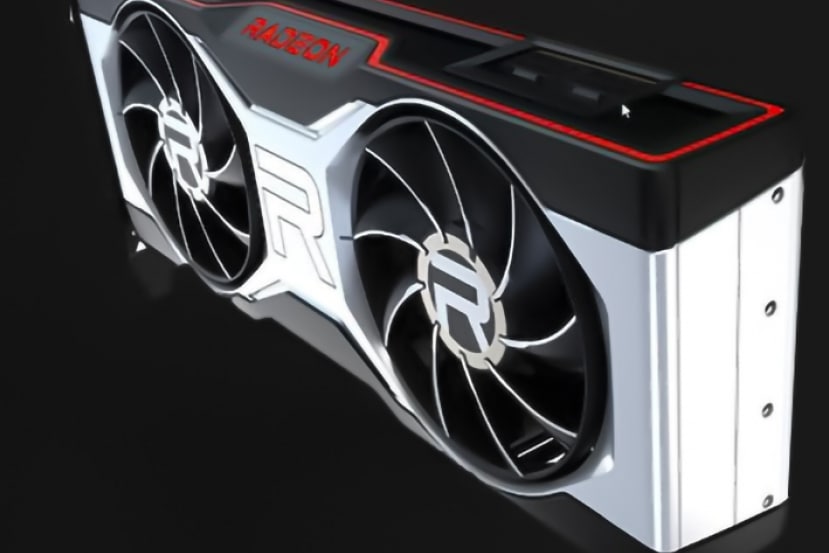AMD Radeon RX 6900 XT Review: Hashrate | Test|CPU – Find how the Overclock, profitability, power consumption and other vital information about the AMD Radeon RX 69000 XT.
Introduction to AMD Radeon RX 6900 XT Features
During the last weeks we have tested both the reference versions of AMD and some of the custom cards based on this new AMD RDNA 2 architecture that have managed to at least match in graphics power to Nvidia’s proposals with the Ampere generation in their models higher end.
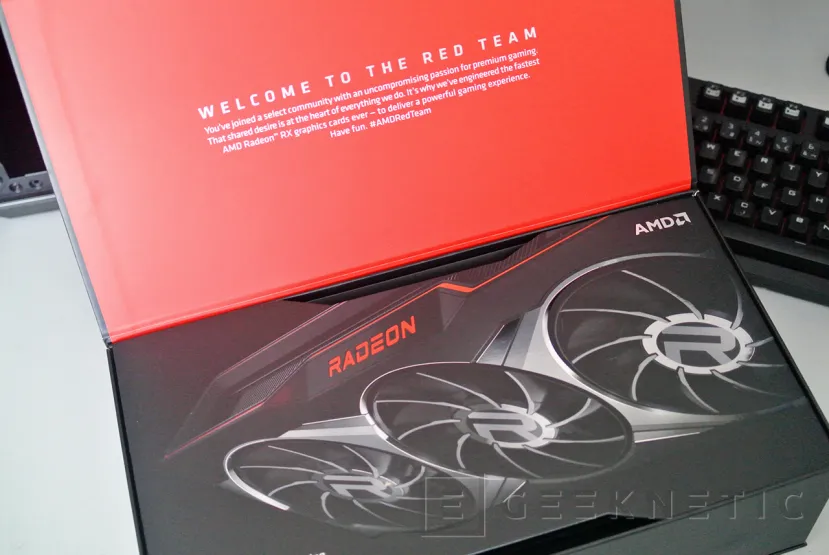
The Radeon RX 6900 XT is currently the best that AMD has to offer with its 7nm FinFET manufacturing process manufactured at TSMC. A manufacturing process with which AMD feels fully comfortable, as we have already seen with the other graphics presented in the Navi 21 architecture and also with the latest generations of AMD Ryzen processors that are giving the brand such good results.
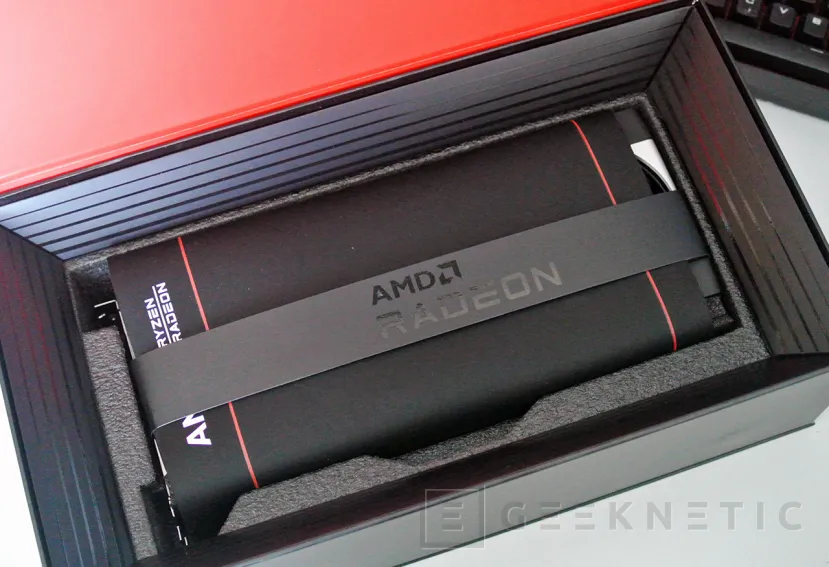
This model delves into taking advantage of this manufacturing process and getting the most, except for surprise, that this new generation of graphics cards based on AMD’s RDNA 2 architecture can offer. That is at least the theory and on paper the truth is that the card looks good, as we will see now in our review, we will also check for ourselves if from paper to practice this card deserves the substantial price increase over the Radeon RX 6800 XT .
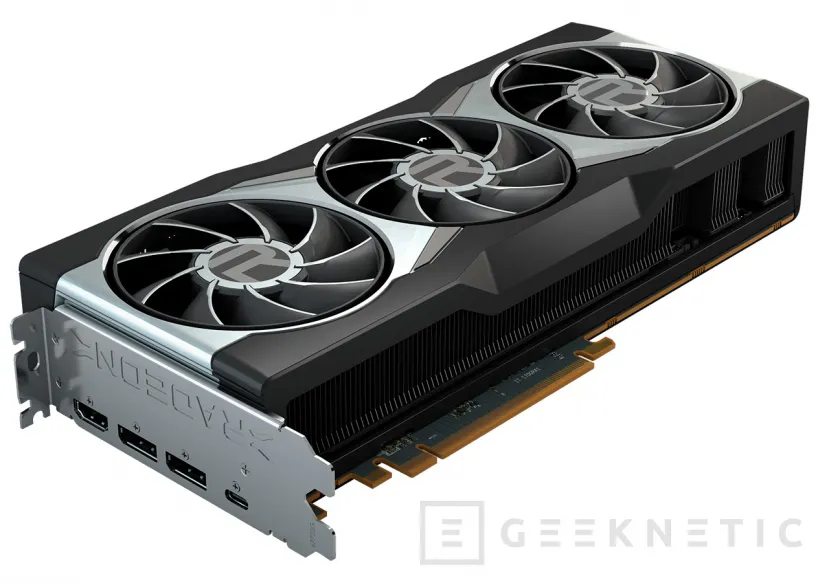
New Features in AMD RDNA 2 Generation
This second generation of AMD’s RDNA architecture comes from the same 7nm FinFET manufacturing process that the Radeon RX 5700 and Radeon RX 5700 XT already enjoyed , in fact, they also use the same communication interface, the PCI Express 4.0 released with the RDNA.

Now AMD has much more experience in this process, in fact, they just surprised with important improvements in the Zen3 processors with this same manufacturing process, so this generation gets much more out of the process with important improvements that I have defined as the three pillars of the RNDA 2.

The family reunited, Radeon RX 6800, Radeon 6800 XT and Radeon 6900 XT.
These three pillars on which AMD’s RDNA 2 architecture is based are the increase in compute units, the increase in work frequency, and the introduction of the Infinity Cache. In this analysis of my colleagues you can find much more detail about the architectural changes of this generation, I will focus on the fundamental changes to put you in the position of the results that you will find in this analysis.
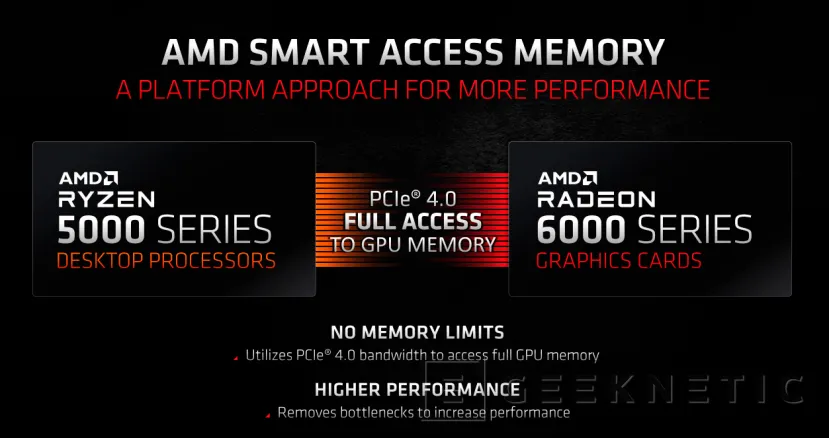
The increase in the RDNA 2 computing units allows not only to increase the card’s processing capacity in classical shading techniques, but also introduces specific units for RayTracing for each computing unit, but always within the DXRT standard that Microsoft introduced some time ago in the DirectX 12 API and they already use many games on the market. The increase in computer units (CU) is 30% in the most basic model of this new generation and double in the most powerful model of this new range.
The second important pillar of performance improvement is found in the ability of these cards to develop higher work frequencies at stake with consumption similar to those of the previous generation, specifically between 250 and 300 watts TDP. We can find up to 400MHz more turbo frequency in some of the models compared to the previous generation and this is based, to a large extent, on the temperatures that this new architecture is capable of supporting.
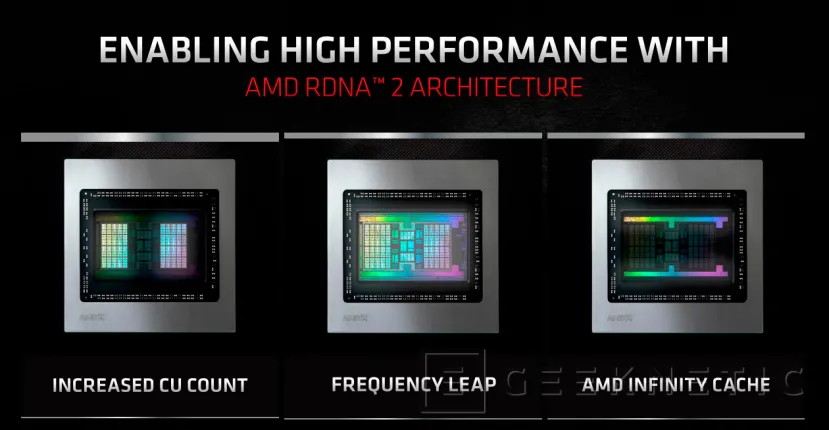
This generation of AMD graphics chips can withstand “T-junction” temperatures, before throttling, of up to 110 degrees Celsius. Now a matrix of temperature sensors allows to know the temperature of the different points of the encapsulation and force frequencies hitherto impossible. This better control and increased temperature support translates into higher sustained frequencies, up to 2200MHz in turbo mode, with more controlled active cooling and therefore less overall noise.
The third pillar of this architecture is found in the AMD Infinity Cache technology, which is 128MB of ultra-fast memory that has been installed in the GPU to maximize the bandwidth in repetitive operations within the card. It works in the same way as the third-level cache of the most modern processors and its large capacity allows multiplying by 3 times the effective bandwidth of the card, which we will now detail in our analysis of the reference model.
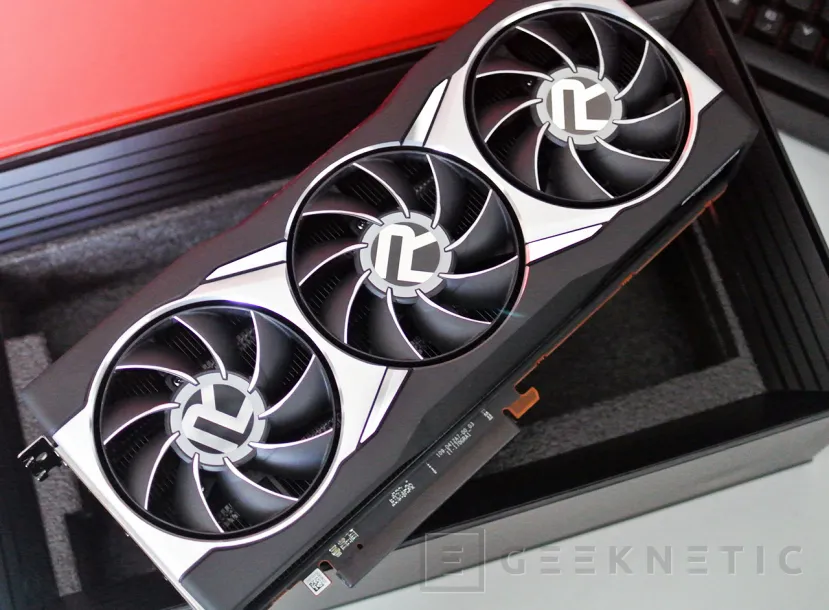
These three fundamental pillars make all this new high-end from AMD, from the Radeon RX 6800 to the Radeon RX 6900 XT, through the Radeon RX 6800 XT, allow 4k gaming and even 2k gaming with active RTX functionality.
Radeon RX 6900 XT Specifications
The Radeon RX 6900 XT is not a very different card from its sisters in the Radeon RX 6800 range , in fact, it has the same size and heatsink as the Radeon RX 6800 XT (in the AMD reference model, of course), and the same TDP consumption, and the same working frequencies and the same connectivity.
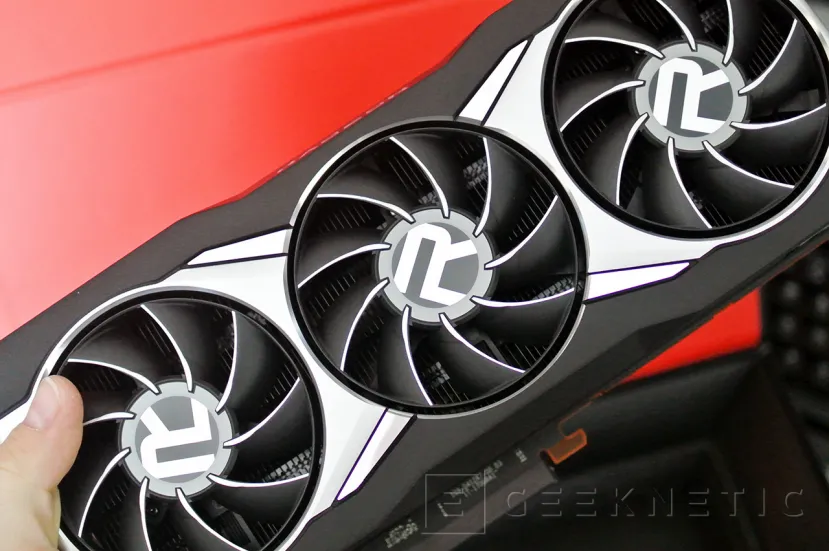
The big difference between this model and the lower-end ones, which is not either very low-end or cheap, is that it takes out the rest of all the computing power of the Navi 21 . The computing units go up to 80, from 72, as well as the RayTracing units that also increase to 80 units .
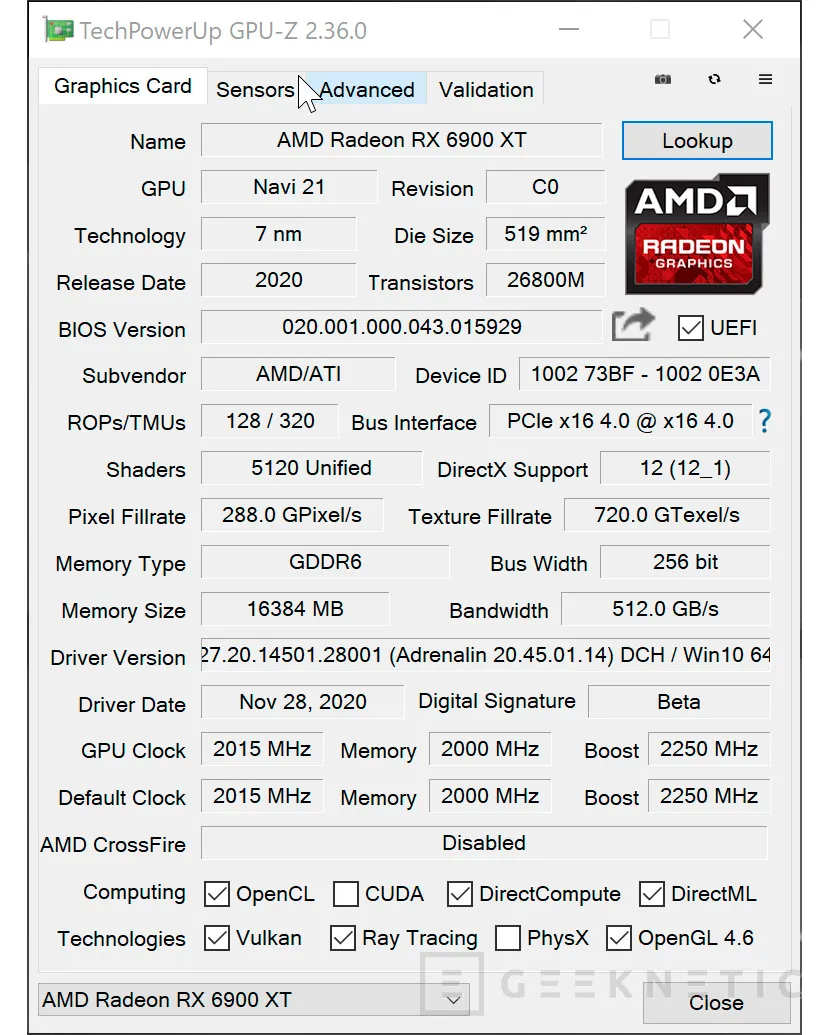
The new number of shading units also increases, in the same way it relates the computing units, from 4608 units to 5120 units . The frequencies remain the same, 2250MHz in Boost mode, with three operating profiles accessible from the Radeon Adrenaline that will allow us to choose quick adjustments that go from a silent mode to another “rage” where we can see peaks in this model of up to 2300MHz.

This card maintains the TDP of 300w , also the size of VRAM with 16GB of GDDR6 memory on a 256-Bit bus capable of generating up to 512GBps of bandwidth that is complemented by the 128MB of Infinity Cache that achieves that the bus of data has up to 3.5 times the performance of cached operations.
The R adeon RX 6900 XT also uses a PCI Express 4.0 bus and with the appropriate AMD architecture (Ryzen 5000 processors and PCI Express 4.0 fifth generation chipsets) and the appropriate motherboard bios, access to Smart Memory Access technology that allows increasing the BAR of memory use of the bus to the GPU from the usual 256MB to the entire VRAM of the card, which also increases the performance of the interface, achieving another extra performance on the card, especially at low resolutions.

It is powered by two 8-pin PEG connectors so we have a total of 450w available to power the card. It’s 150w per connector and an extra 150w for the 16x PCI Express 4.0 connector. AMD recommends a source of at least 850w to move this graphics card with the rest of the hardware that is expected for a high-end card.
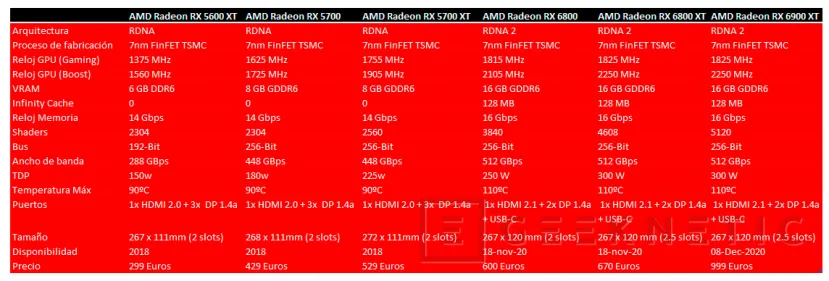
There are other numbers that increase with the increase in computing units, we go to 320 texturing units, compared to the 288 texturing units of the Radeon RX 6800 XT, the 128 ROP units are maintained and its computing power increases to 46 TFlops in single precision and up to 23 TFlops in double precision.
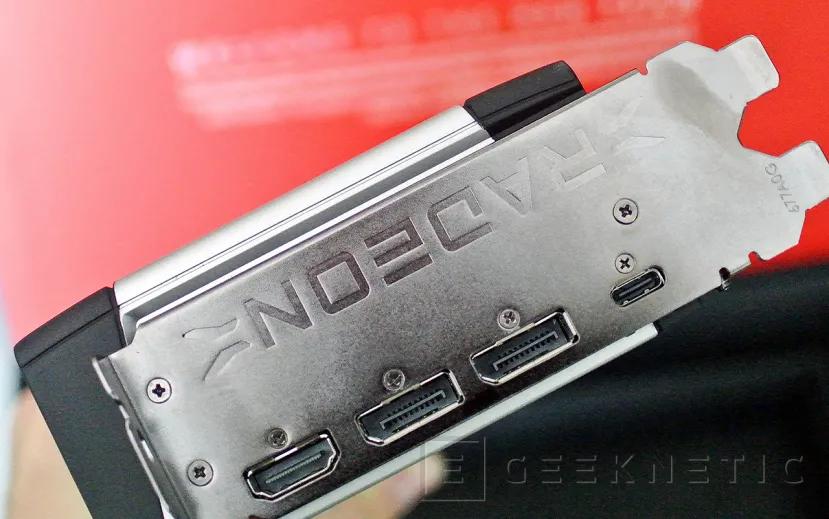
Connectivity is state-of-the-art with two Displayport 1.4 ports with 8k resolution, 1 HDMI 2.1 VRR (Variable Refresh Rate) connector and a full functionality USB-C port that includes Displayport Alternate Mode (1.4), USB 3.1 and USB-C support PD with up to 30w of charging power . This connector will allow us to bring state-of-the-art Freesync monitors to life as well as VR HMD systems with data, video and power through a single USB-C cable.
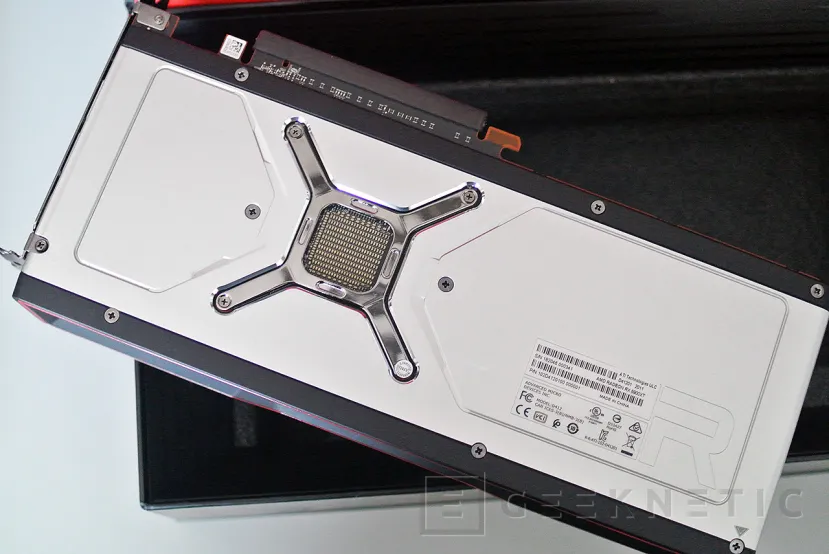
Reference design and new RGB software
The Radeon RX 6900 XT uses exactly the same design as the Radeon RX 6800 XT and it is logical since both models share the same performance in terms of consumption and thermal response. It is a 120mm high, 267mm long and 2.5 slots wide card that makes it noticeably more compact than the other high-end alternative, the GeForce RTX 3090 , which reaches 320mm long and three slots thick.

The 300w TDP of this card is managed by a large steam chamber heatsink that is cooled by three variable speed axial fans that also have a complete stop mode when the card is below 60 degrees, which is its temperature. resting.

The Radeon RX 6800 is somewhat narrower, but the Radeon RX 6800 XT and Radeon 6900 XT are “twin brothers”.
In the design of this card, as in the rest of the range, AMD has used a 14-layer PCB where we find 16 power phases for the GPU . The design includes high heat transfer thermalpads for MosFETs and memories, as well as a graphite-based exchange plate.

The card is designed to expel air from the side, in fact, there is no front grille, which will force us to improve ventilation inside the PC chassis, but it is perfectly compatible with mounting multiple cards on the same computer. You have to think that this model will also be a good alternative, due to its processing power, for professionals who want to replace older, less powerful models, such as the Radeon VII for professional tasks.
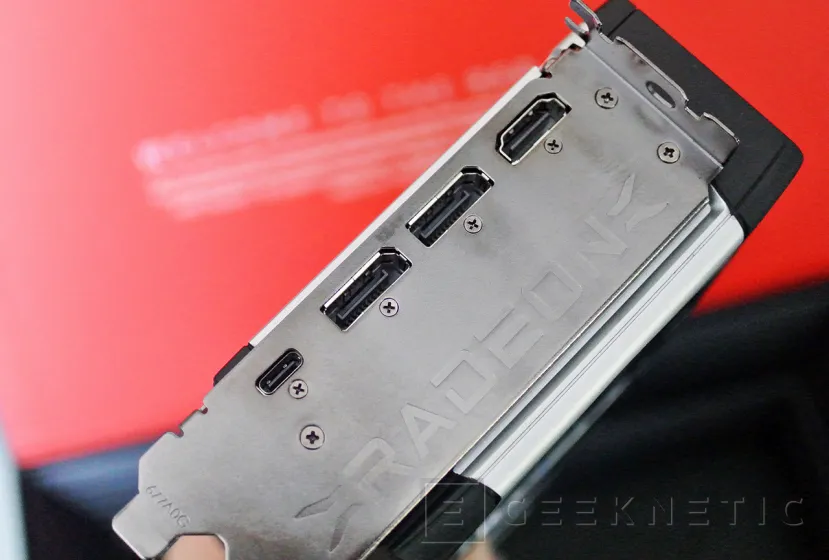
The design is much more elaborate than models of the step, such as the Radeon RX 5700, much quieter and more efficient, with a general behavior that even overshadows the best custom models of the most famous manufacturers for their powerful and silent graphics solutions.
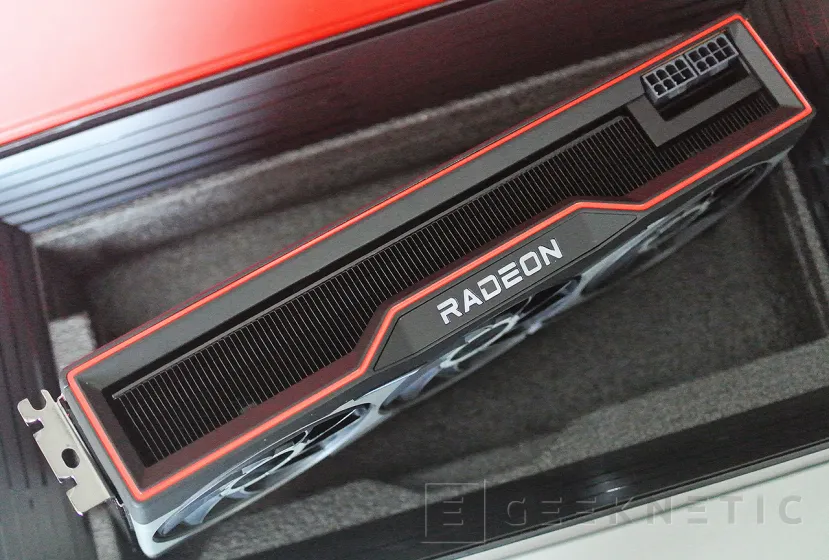
The surprise, as I predicted in my article on the Radeon RX 6800 XT, and I promise I had no clue about it, comes from the hand of a new application that AMD will put in the hands of the user with which the lighting of the car can be customized. Radeon side logo, which by default lights up in the brand’s classic red. Now we can customize it from Windows. At the moment it does not offer many effects, the most striking being the MORSE mode, where we can configure personalized messages that will be played in MORSE-encoded blinks.
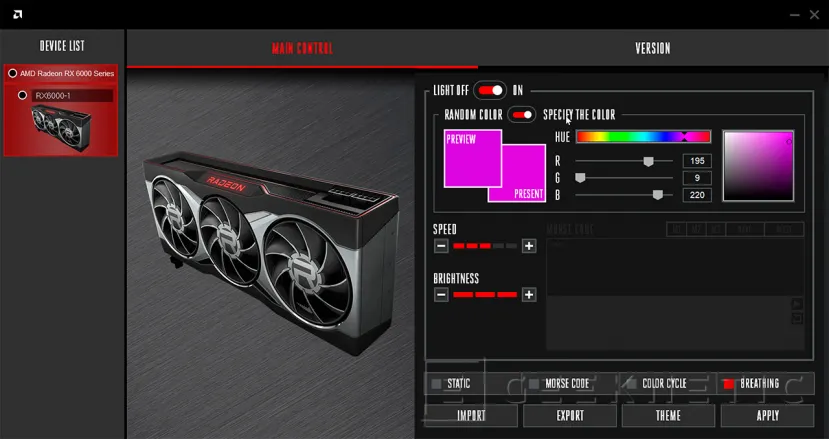
Noise, consumption and temperature at standard speeds
We already had a lot of experience with the performance of the Radeon RX 6800 XT reference model. It is a card design that combines a good frequency margin, which the card takes advantage of above its own specifications, with good thermal and sound behavior. We have not found a very different performance in it, with a bit more heat, but certainly close to its little sister, which seems to suggest that the increase in computing units does not affect the design much, it is more a matter of sustained frequencies.

We have seen the same improvement as in its little sister, with 2350MHz of peak frequency holding the Boost frequencies well in games, hovering around 2200MHz, generating extraordinary performance and I would say almost unexpected, although AMD has been boasting its alternative to the powerful GeForce RTX 3090.
Working temperatures are also as expected with global temperature stabilized above 70 degrees, with hot spot temperatures around 86 degrees, just slightly higher than its format sister, the Radeon RX 6800 XT, which gave us a average 85 degrees. The fans are also kept at 1400-1450rpm under stress, which is no more than 35-36dBA of noise generated by the card. In addition, it leaves us a good margin for overclocking.
Standstill temperature

Charge temperature
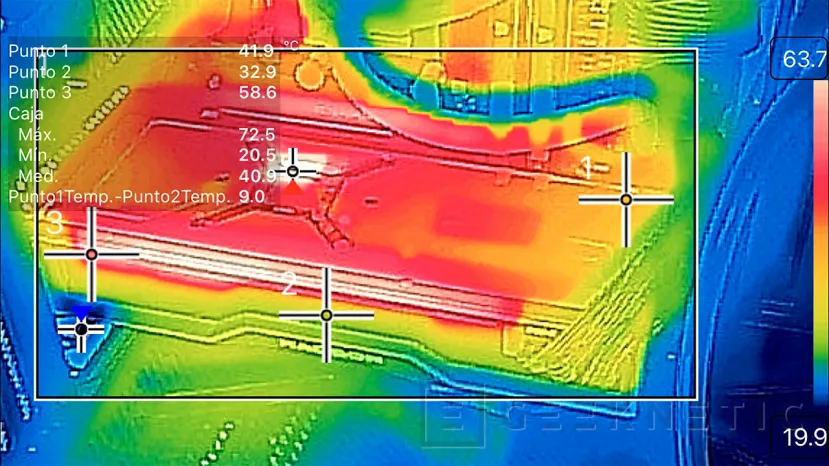
Overclock
In the case of the Radeon RX 6900 XT we also see the same improvement in frequencies thanks to the increase in cooling and available TDP that we saw in the Radeon RX 6800 XT, at the moment they are very similar cards surely due to their shared working frequencies . This has led us to very similar results with frequency increases, without the need to touch voltages, up to 2500MHZ in peak over 2350MHz stable in games, which translates into a performance improvement, over its own results, around 4 % on average.
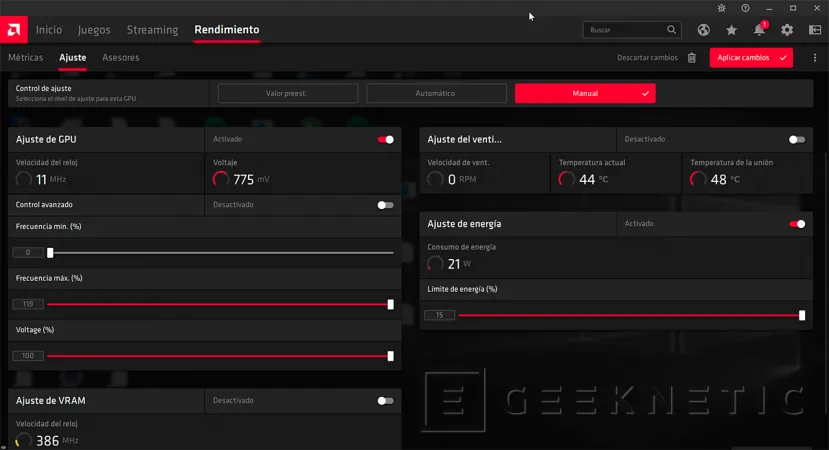
It’s not much, to be sure, but the card has its very established working temperatures, much more conservative than the 110 degrees that AMD talks about in its specifications, which makes the overall performance not increase much, luckily neither does it noise, which is always below 40dBA in our tests. That is normal behavior, the fans can support frequencies of 3000rpm where the noise exceeds 55dBA, luckily we will not have to play at these frequencies unless our environmental conditions are really adverse or we have poorly designed the ventilation of our PC (We always do the tests of our graphics mounted in normal boxes, like those that any of you can have at home).

Pruebas DXRT y AMD Boost y Smart Memory Access
Testing machine:
- Placa base: Gigabyte Aorus Master X570
- Procesador: AMD Ryzen 3950X
- Memory: 16GB DDR4 3600
- Fuente: Seasonic Connect 750w
- Hard Drive: Corsair MP600
To know the benefits of this card with some of its new and not so new tricks, we have taken some specific games capable of taking advantage of these benefits and we have made a brief comparison of results. We already knew about the Boost improvement, but now we also have the option of using Ray Tracing in some games, with very good results up to 1440p resolution and we have also been able to verify the slight but effective performance improvement using the full access mode to memory through PCI Express 4.0 . In these tests we can see an improvement of around 3-4% depending on the resolution over the Radeon RX 6800 XT , not much considering the price difference.

Performance
Ashes of the Singularity (DX12) 1080

DOOM (Vulkan) ultra 1080
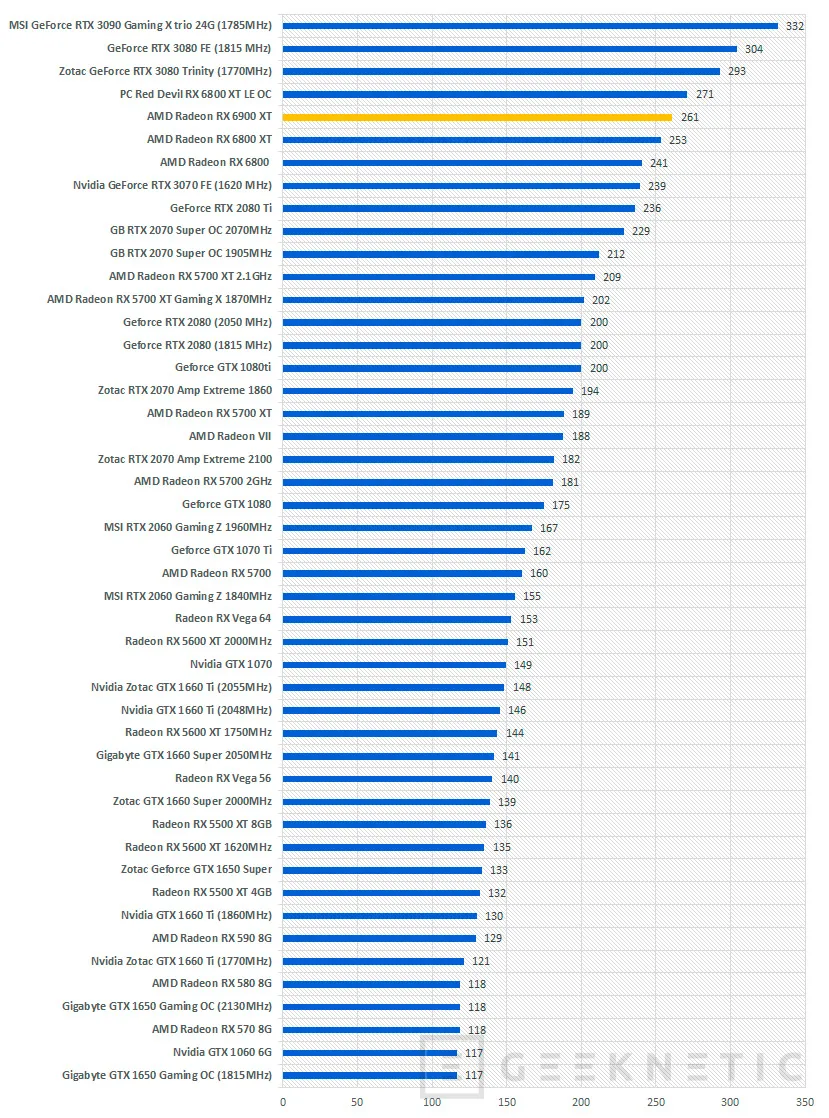
Halo Wars 2 (DX12) ultra 1080

Ghost Recon Wildlands (DX11) ultra 1080

Total War: Warhammer (DX12) ultra 1080

Battlefield 1 (DX12) ultra 1080
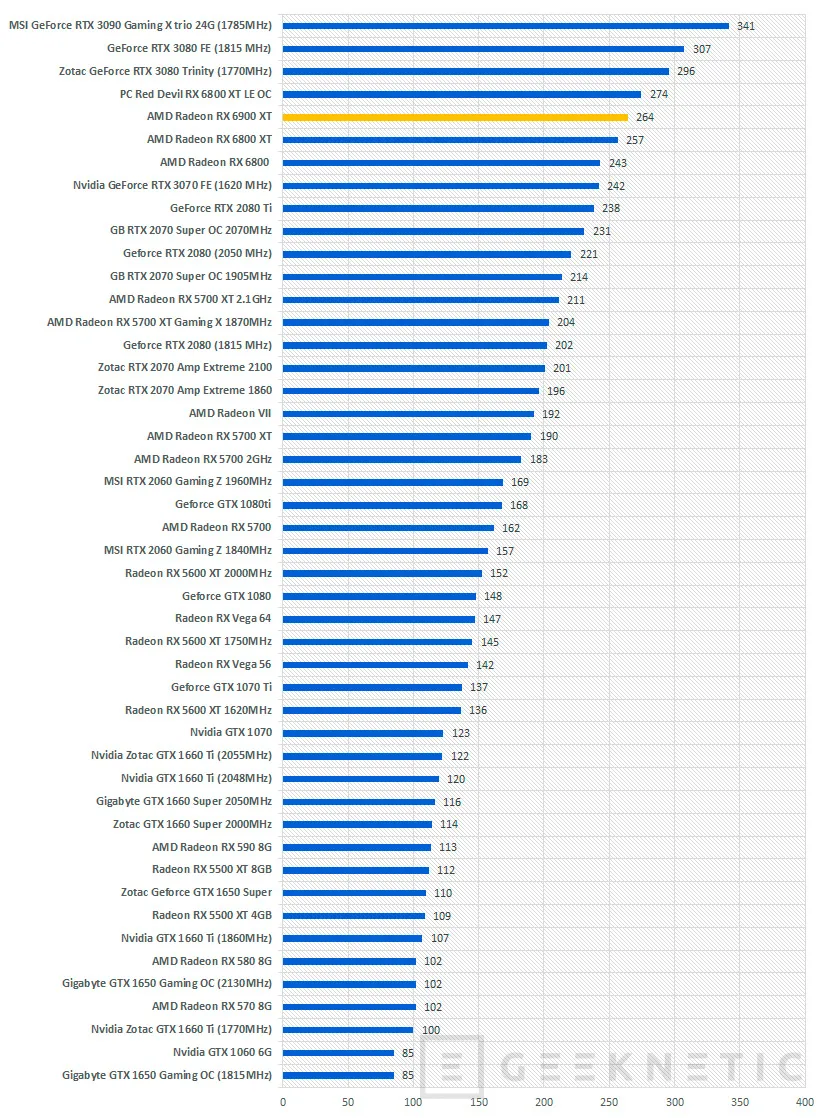
StarWars BattleFront 2 ultra (DX12) ultra 1080
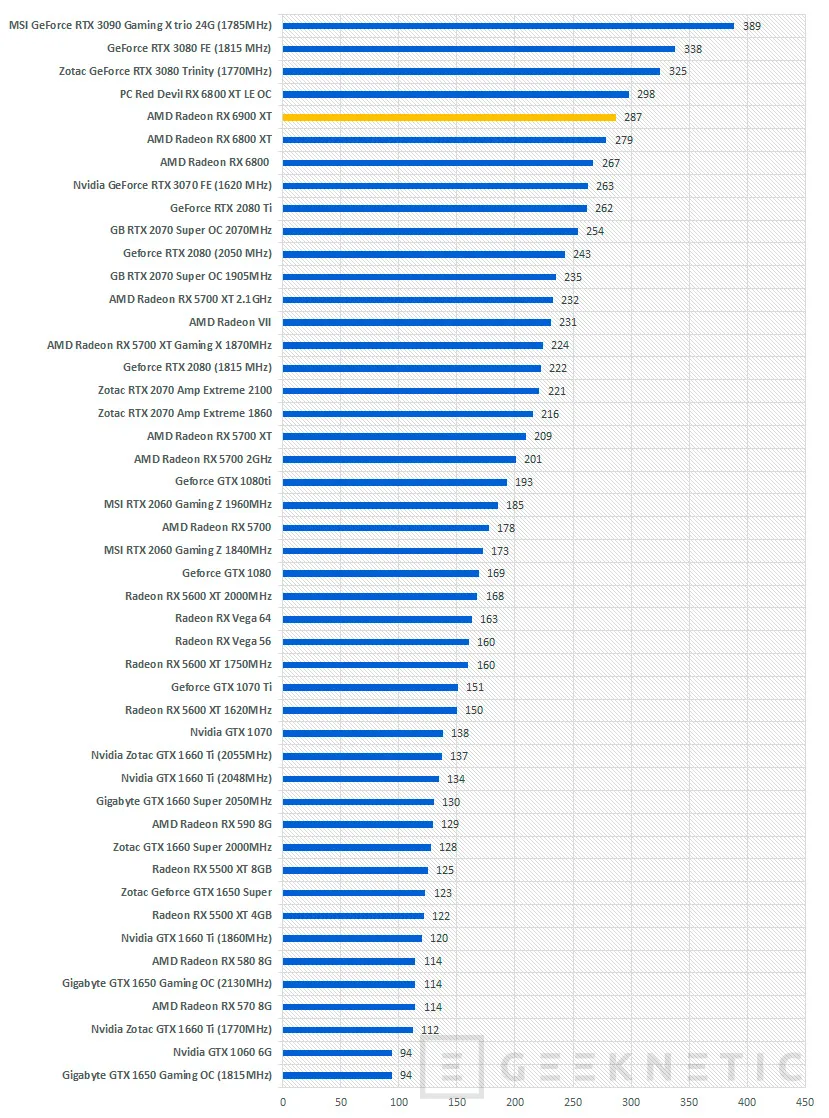
Battlefield V (DX12) ultra 1080
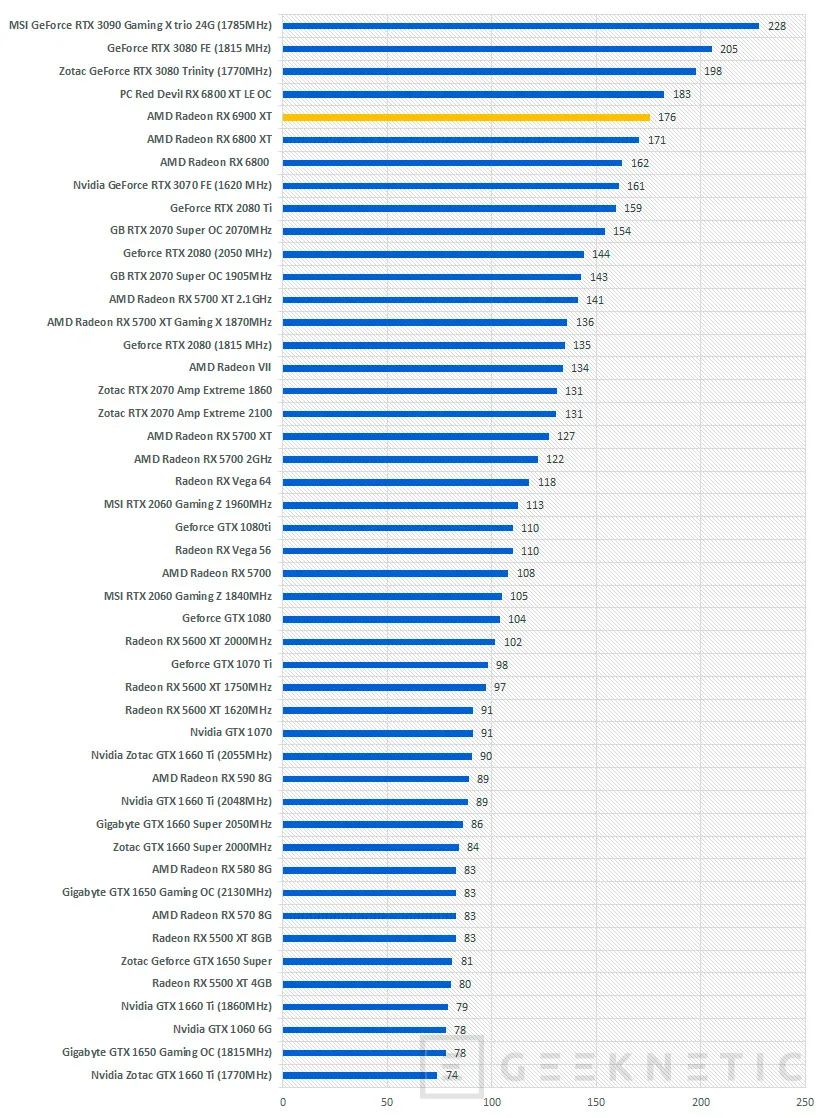
Doom Eternal ultra 1080
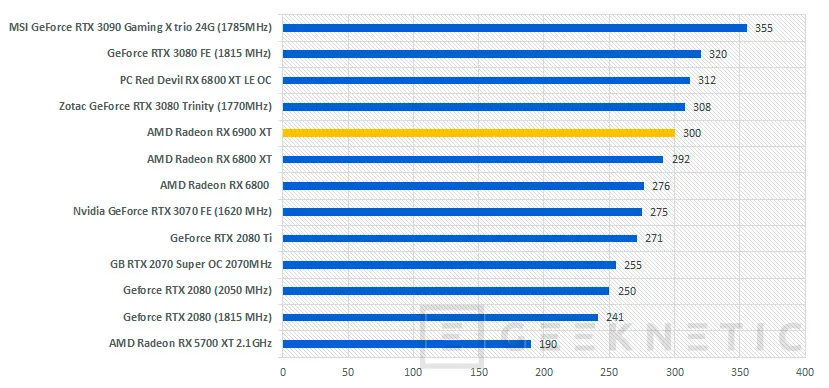
Flight Simulator Ultra 1080

Ashes of the Singularity (DX12) 1440
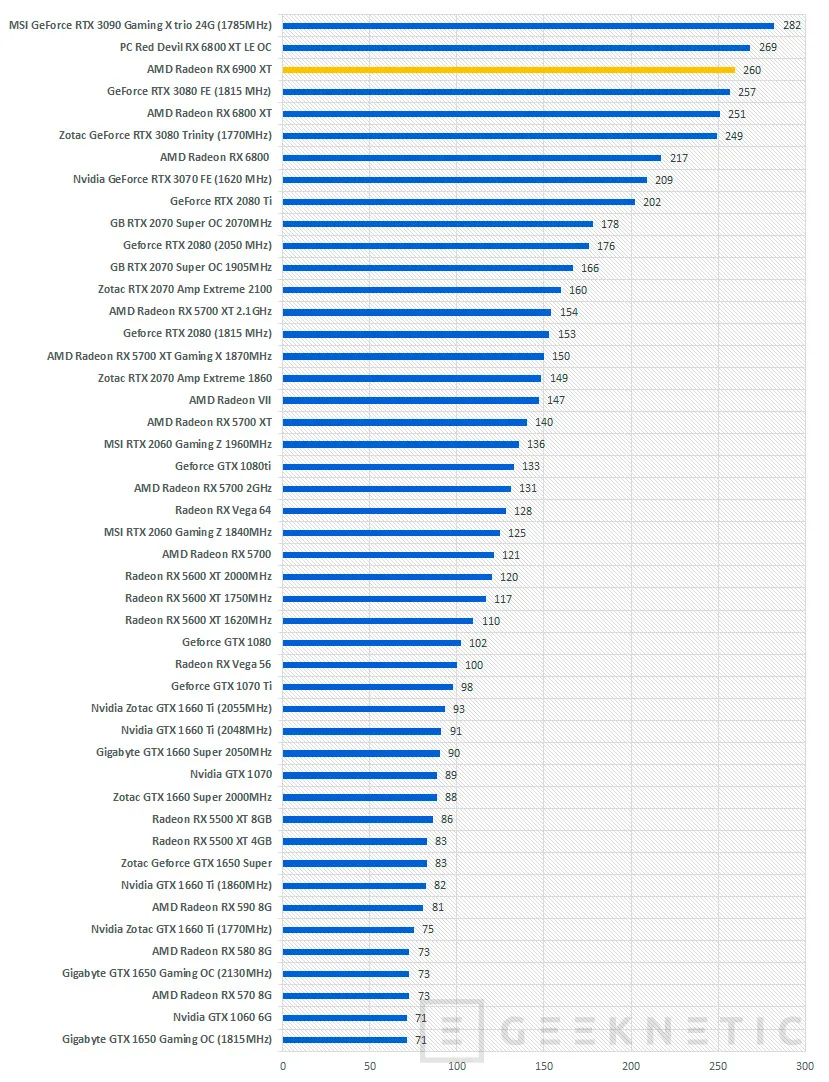
DOOM (Vulkan) ultra 1440

Halo Wars 2 (DX12) ultra 1440

Ghost Recon Wildlands (DX11) ultra 1440

Total War: Warhammer (DX12) ultra 1440
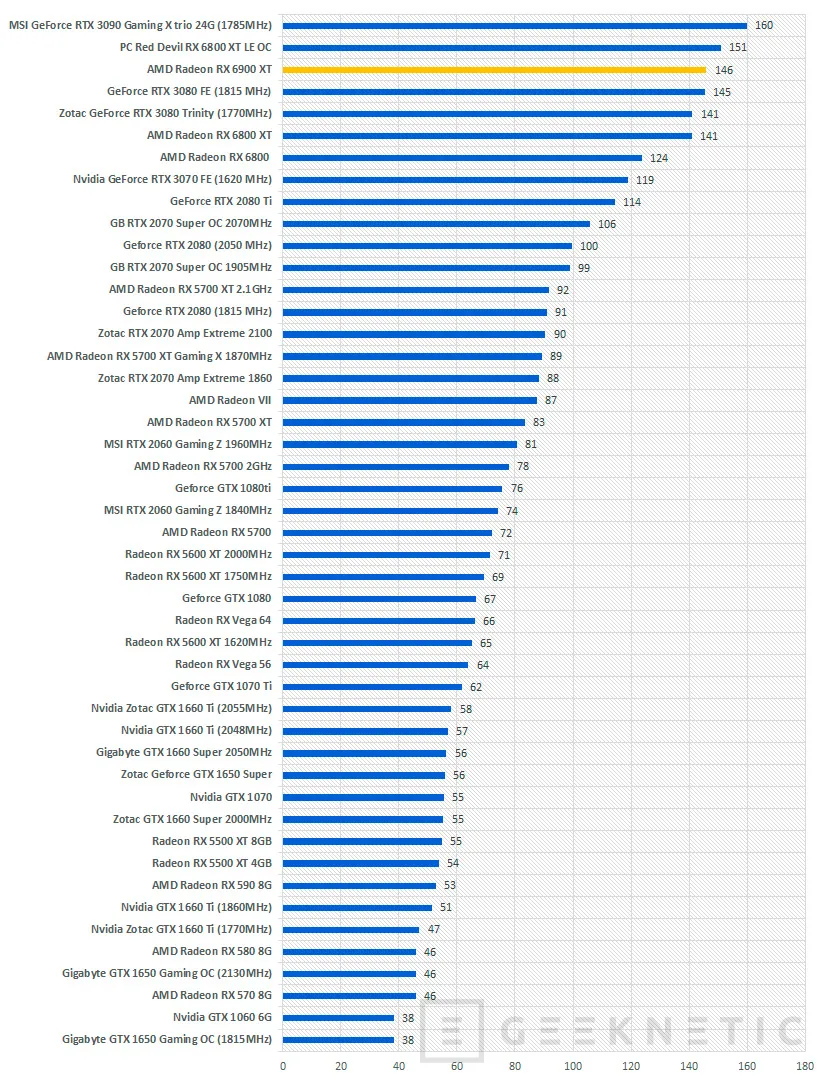
Battlefield 1 (DX12) ultra 1440
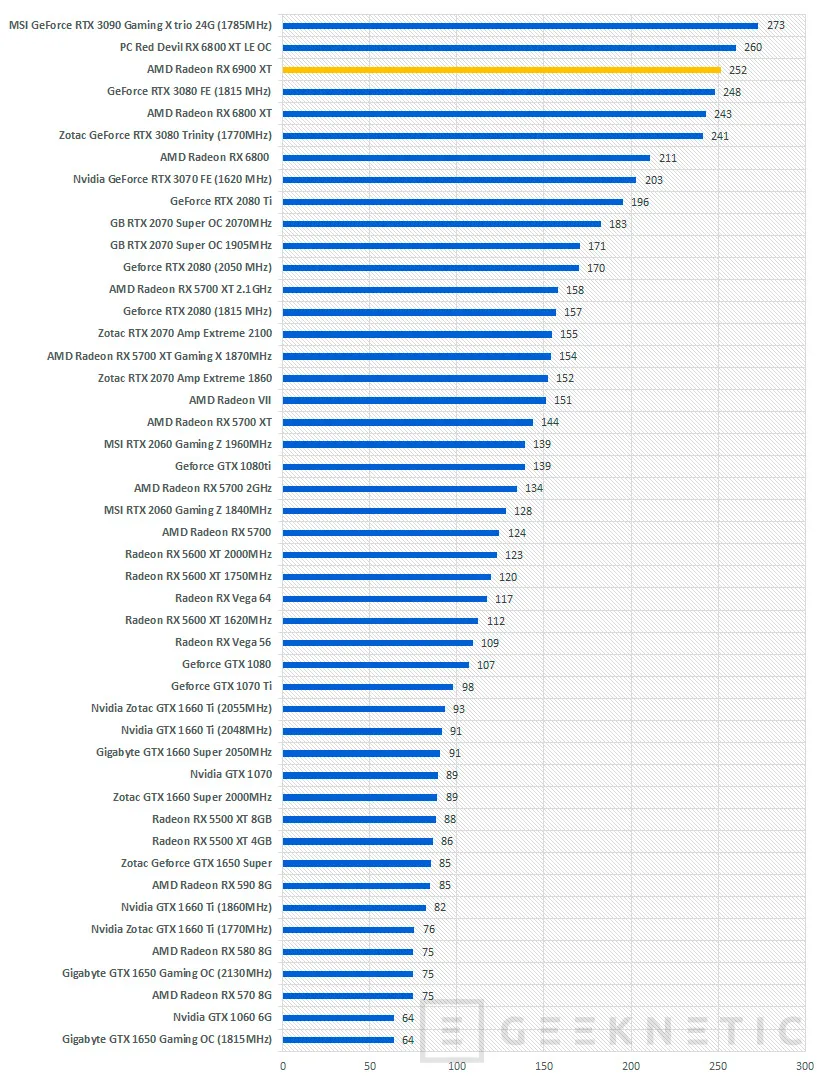
StarWars BattleFront 2 ultra (DX12) ultra 1440
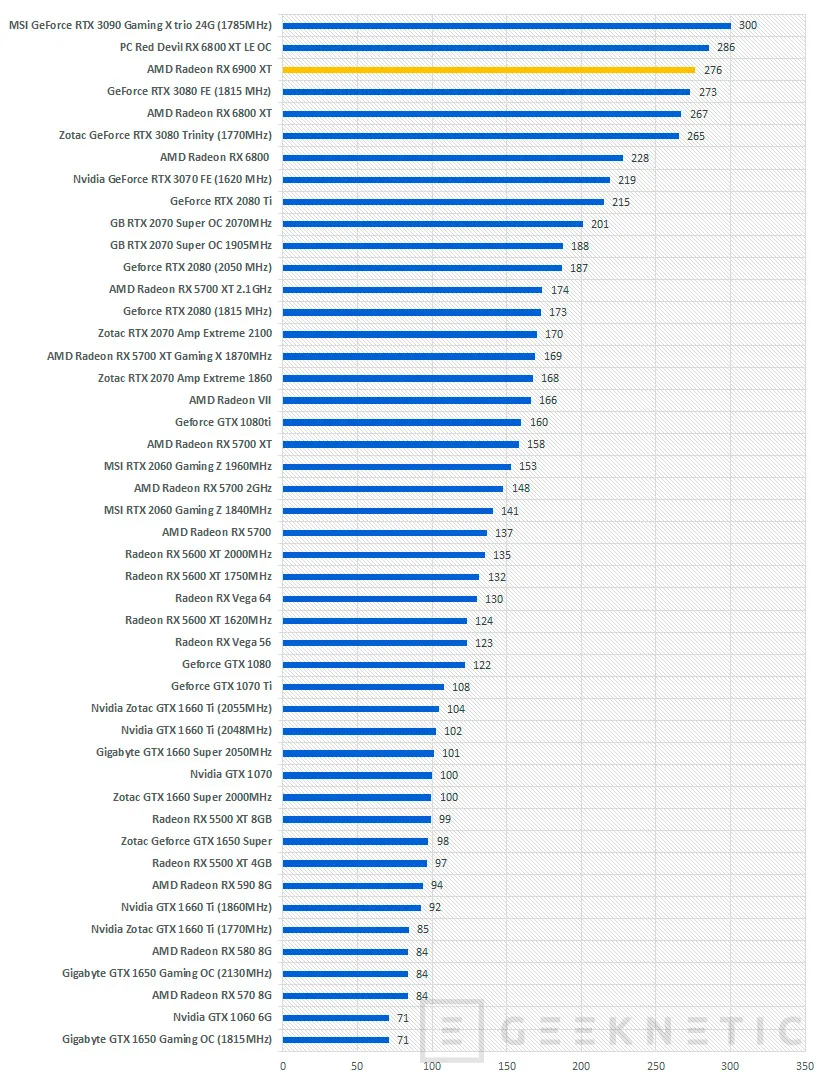
Battlefield V (DX12) ultra 1440

Doom Eternal ultra 1440
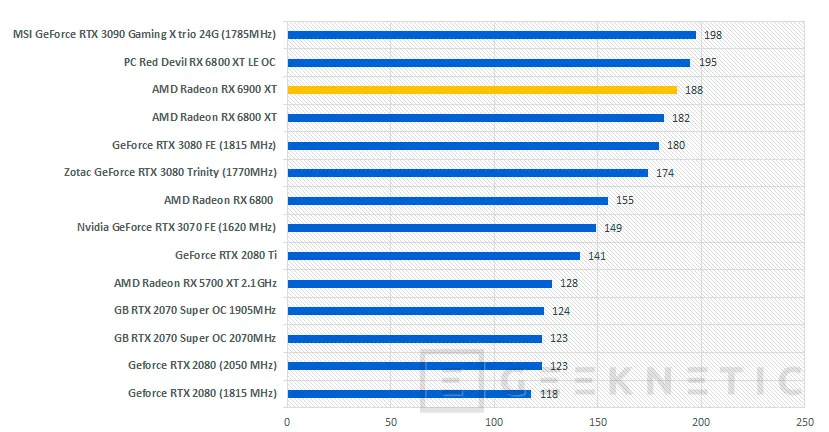
Fight Simulator Ultra 1440
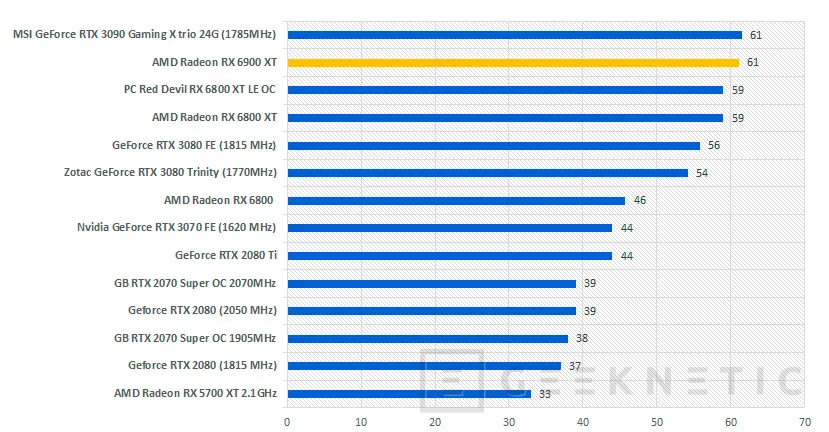
Ashes of the Singularity (DX12) 2160
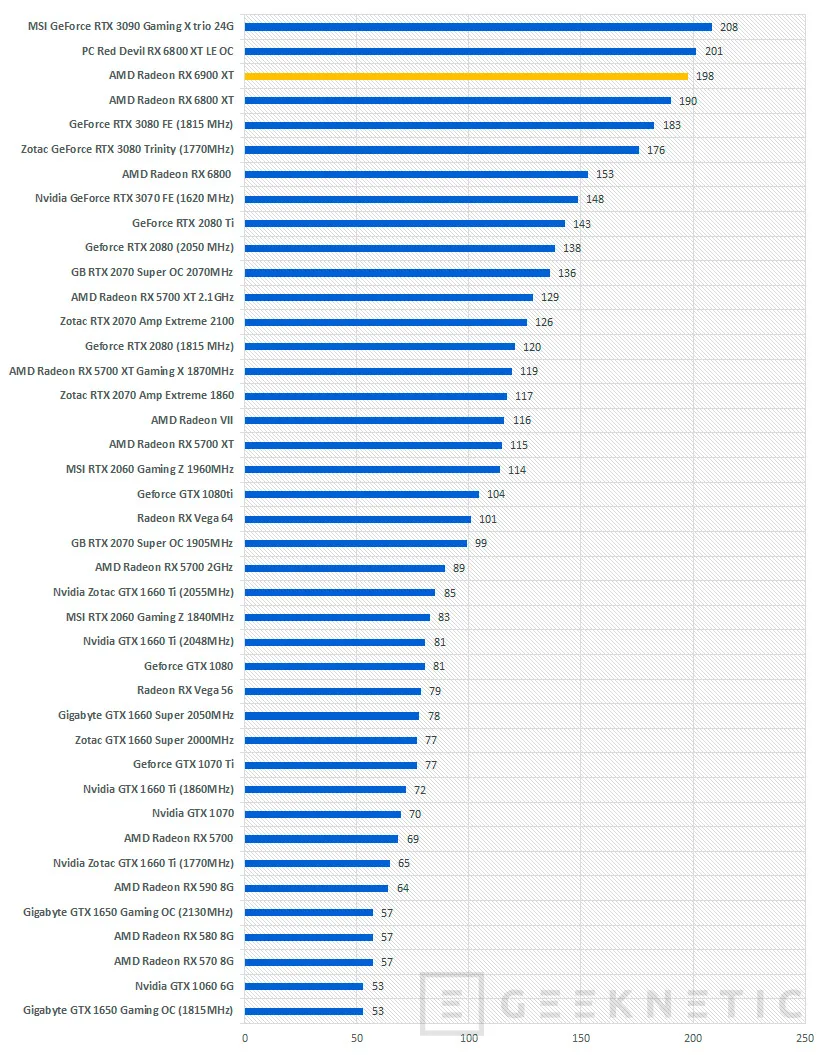
DOOM (Vulkan) ultra 2160
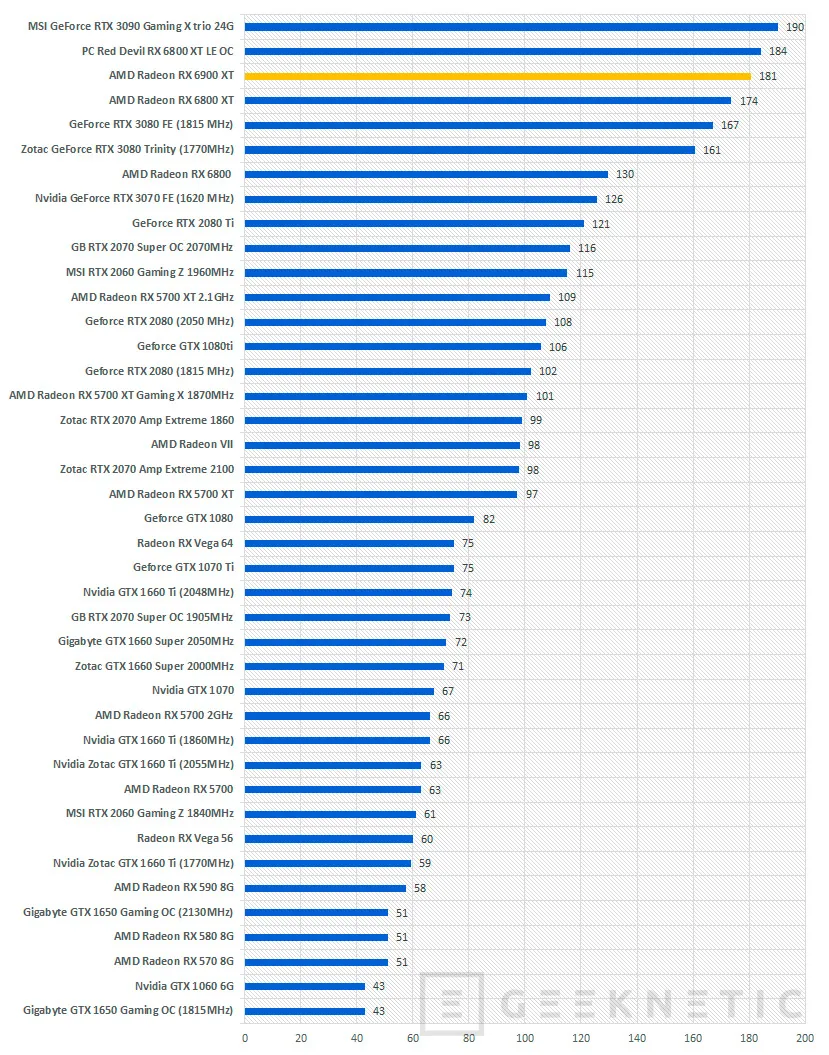
Halo Wars 2 (DX12) ultra 2160
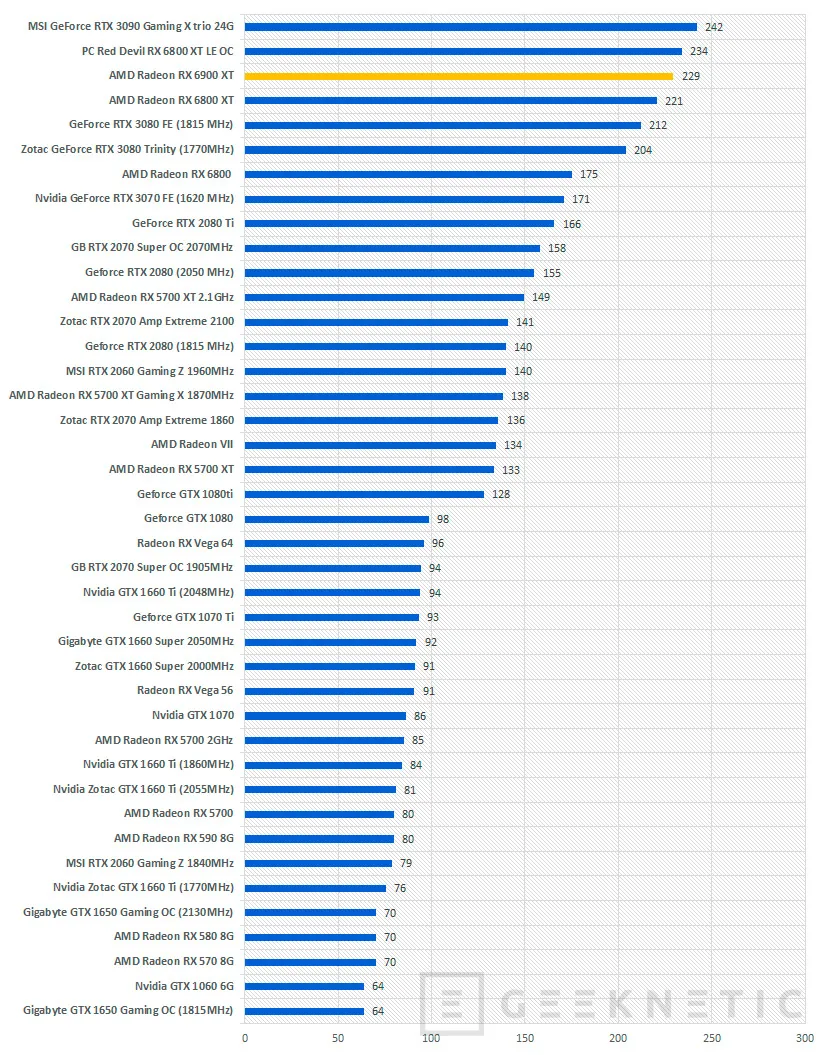
Ghost Recon Wildlands (DX11) ultra 2160
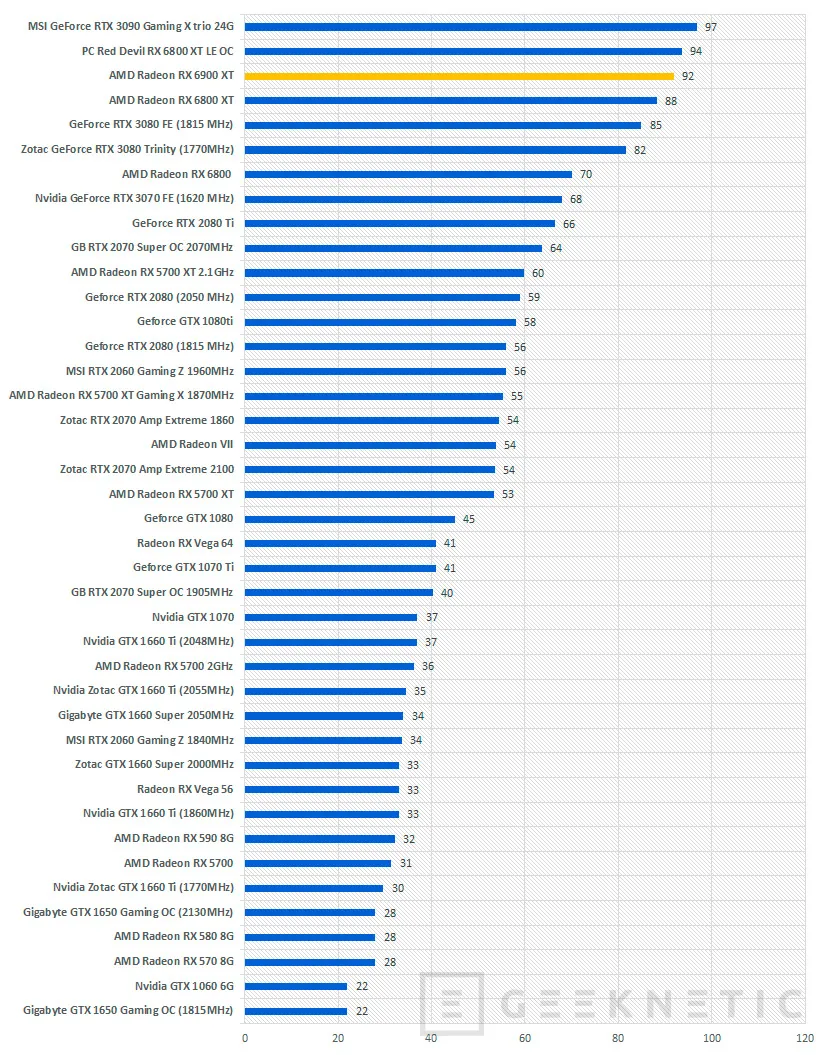
Total War: Warhammer (DX12) ultra 2160
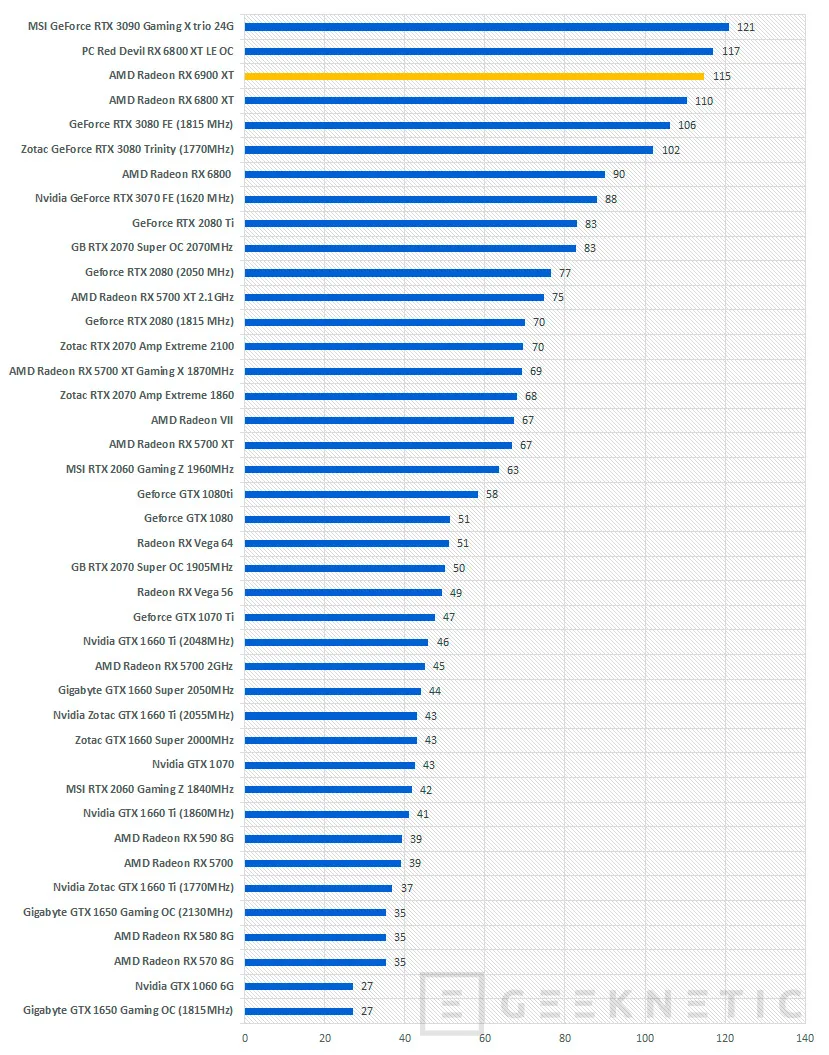
Battlefield 1 (DX12) ultra 2160
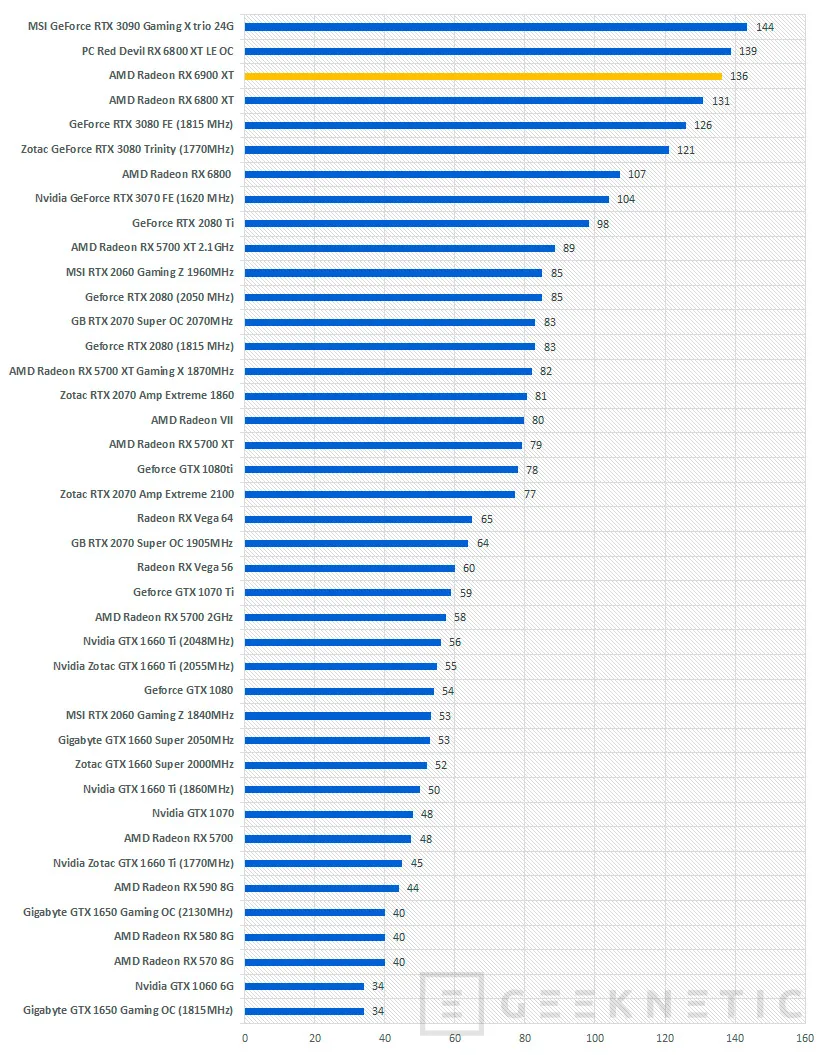
StarWars BattleFront 2 ultra (DX12) ultra 2160
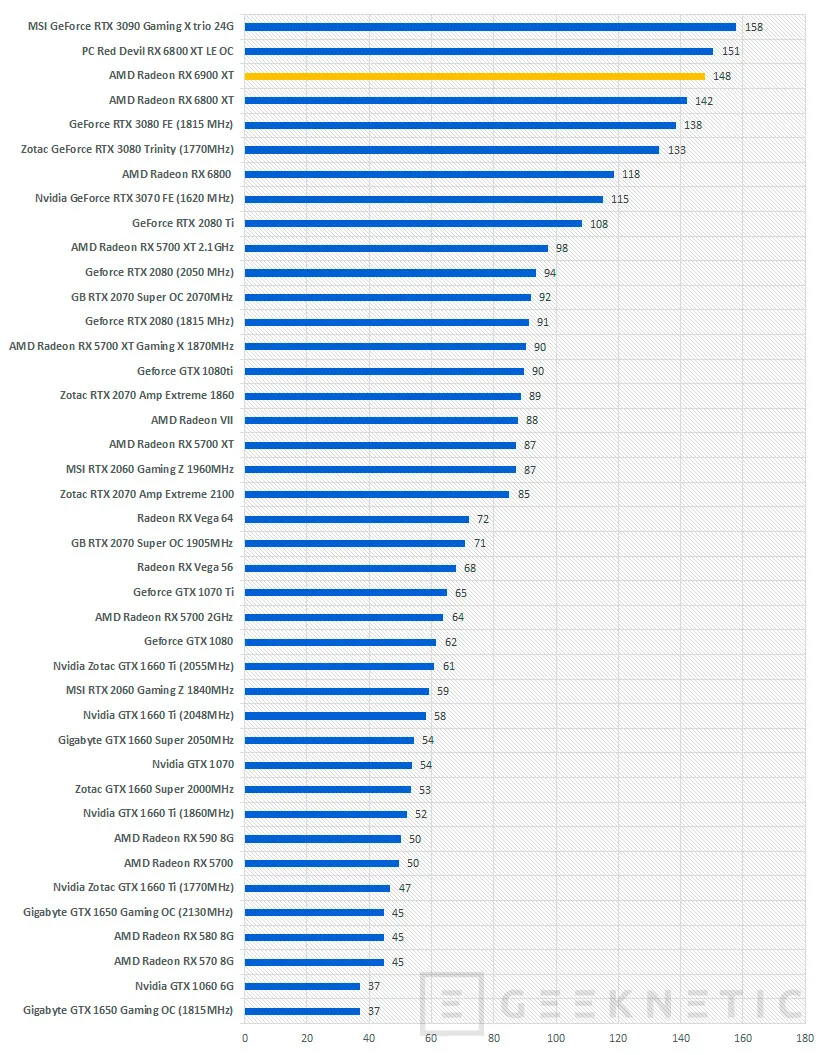
Battlefield V (DX12) ultra 2160
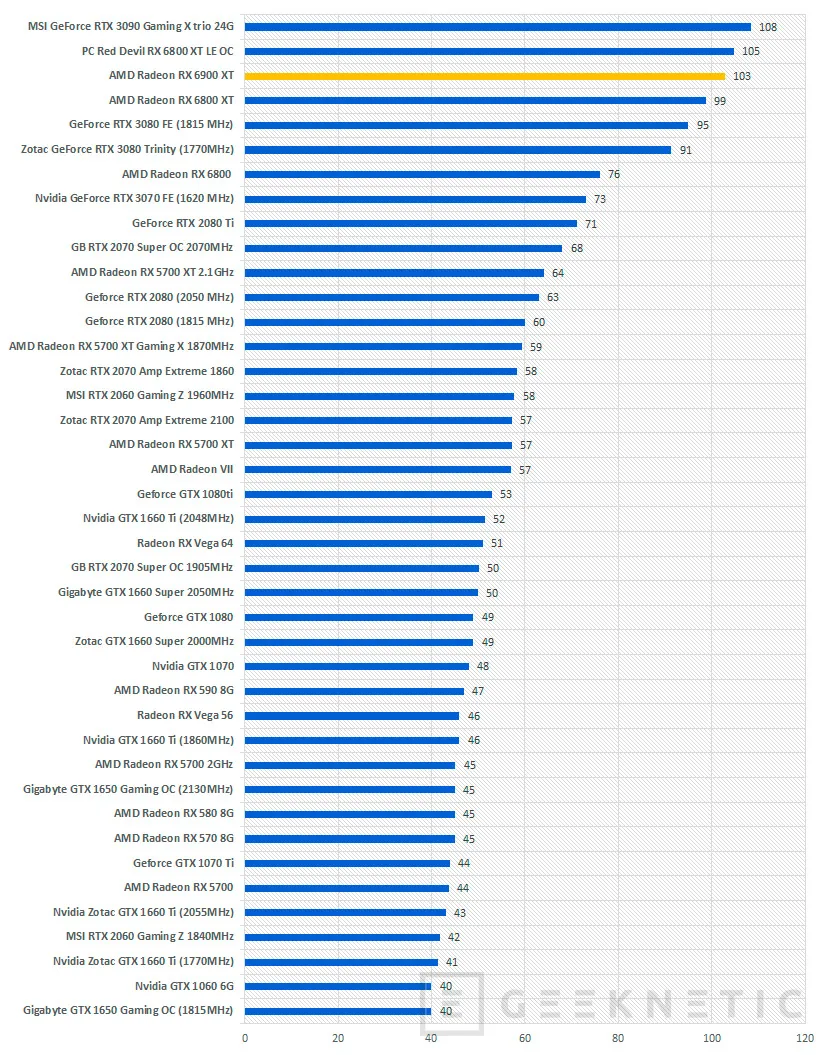
Doom Eternal ultra 2160

Fight Simulator Ultra 2160
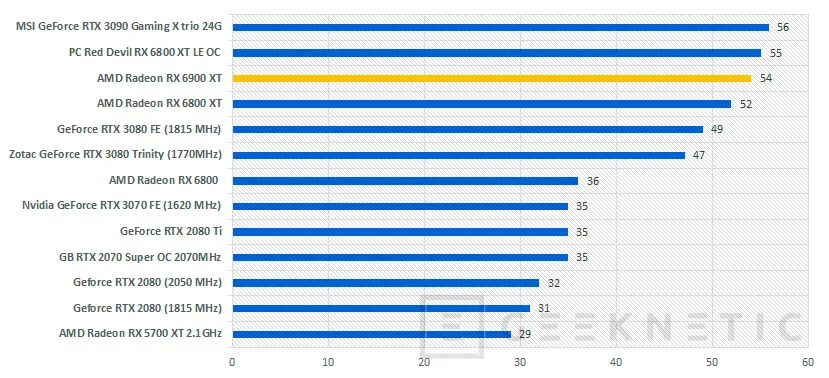
3DMark Firestrike
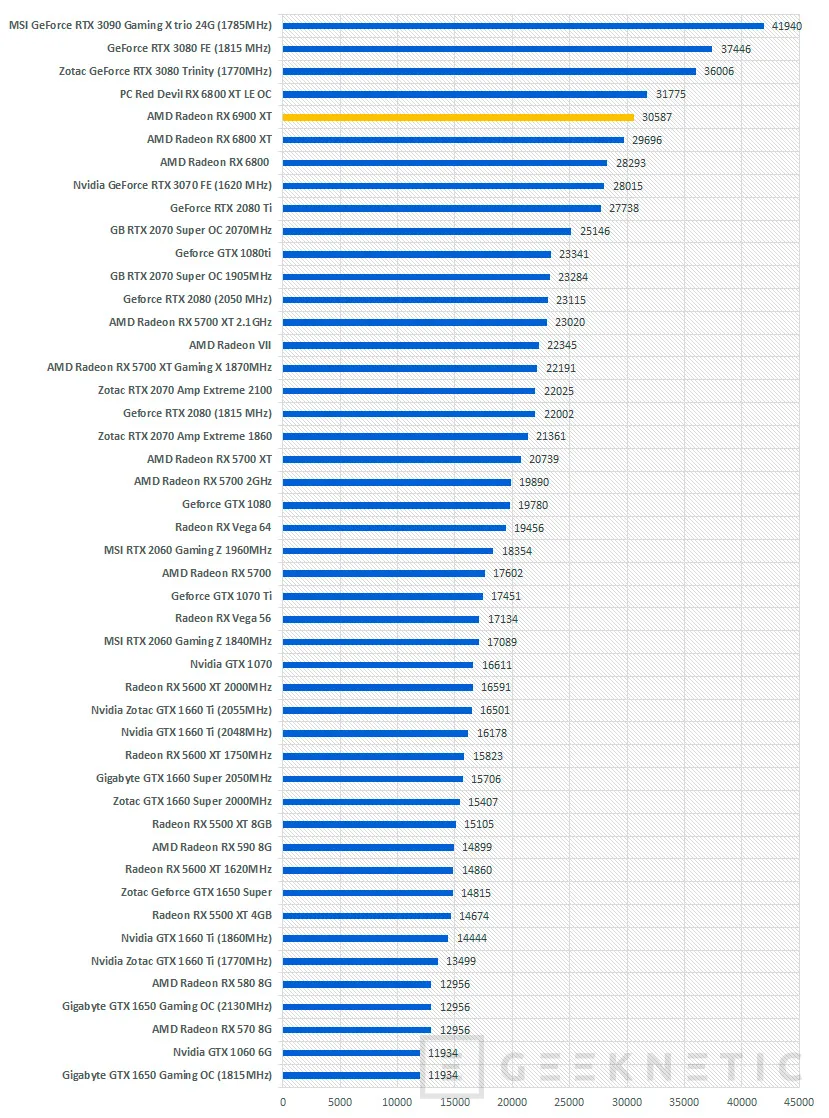
3DMark Firestrike Ultra

VRMark Orange Room
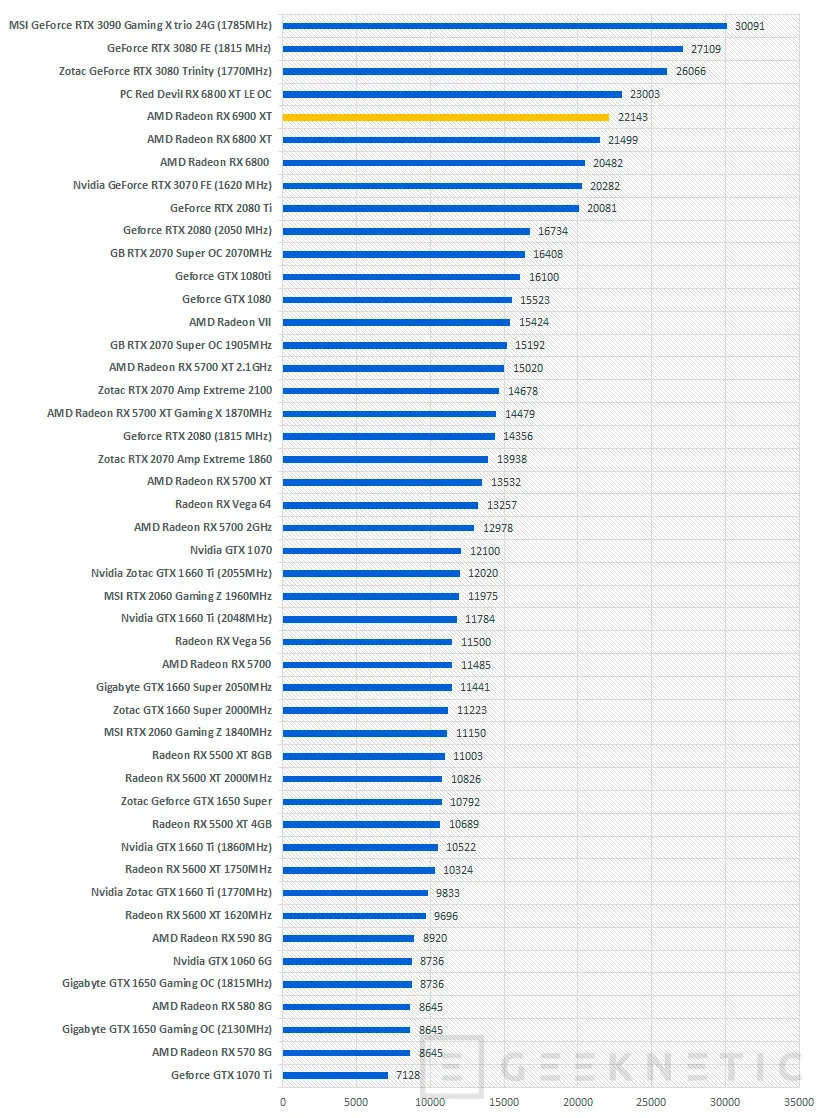
VRMark Cian Room
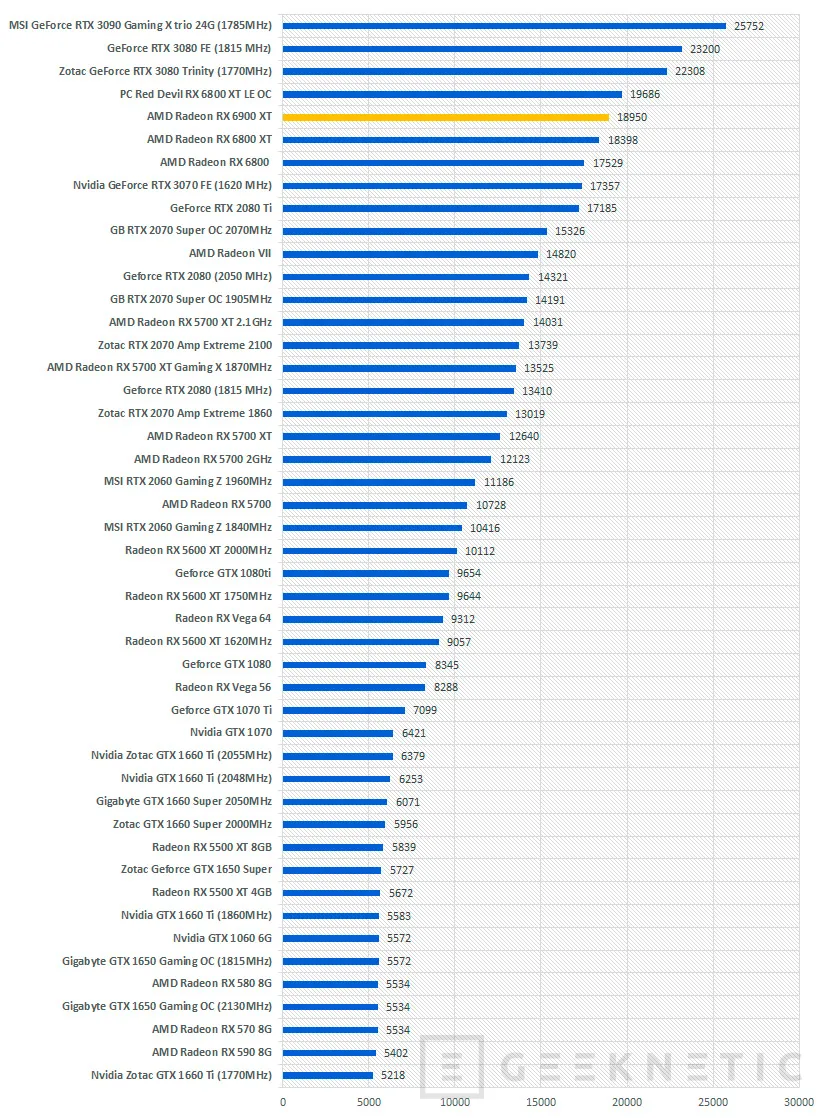
Doom Eternal 4k gameplay in Ultra quality:
Analysis and conclusion
The Radeon RX 6900 XT is an extraordinary card in performance that is on par with the GeForce RTX 3090, but on the other hand it has the same shortcomings as the Nvidia model. I understand that both are exclusive models that are looking for the most demanding customer who does not mind paying a significant extra to have that FPS improvement in any game and any resolution.

Now is when we have to make our own assessment if we want to pay those 240 Euros more than this reference model costs compared to other reference models of the Radeon RX 6800 XT. Well, that’s if you can find one at this point in history. I know how it seems to me to pay a lot, although on the other hand it is clear that from you to you with respect to the RTX 3090, the card is significantly superior, although it is not in all games.

Compared to the card it is trying to dethrone, this card is more compact, much cheaper, consumes less, has a more varied connectivity and when it comes down to it, it defends itself better than well against this important opponent. Now if we see an important difference in performance-price with respect to the competition, the Radeon RX 6900 XT is the true competition of Nvidia, the problem is that I do not know if it really compensates with respect to the Radeon RX 6900 XT, although it is also It is true that this same question can be asked between the GeForce RTX 3080 and the RTX 3090.





